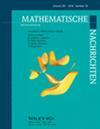Rodrigo A. H. M. Cabral, Michael Forger, Severino T. Melo
求助PDF
{"title":"微分模与里费尔代数","authors":"Rodrigo A. H. M. Cabral, Michael Forger, Severino T. Melo","doi":"10.1002/mana.12019","DOIUrl":null,"url":null,"abstract":"<p>We develop criteria to guarantee uniqueness of the <span></span><math>\n <semantics>\n <msup>\n <mi>C</mi>\n <mo>∗</mo>\n </msup>\n <annotation>${\\rm C}^*$</annotation>\n </semantics></math>-norm on a <span></span><math>\n <semantics>\n <mo>∗</mo>\n <annotation>$*$</annotation>\n </semantics></math>-algebra <span></span><math>\n <semantics>\n <mi>B</mi>\n <annotation>$\\mathcal {B}$</annotation>\n </semantics></math>. Nontrivial examples are provided by the noncommutative algebras of <span></span><math>\n <semantics>\n <mi>C</mi>\n <annotation>$\\mathcal {C}$</annotation>\n </semantics></math>-valued functions <span></span><math>\n <semantics>\n <mrow>\n <msubsup>\n <mi>S</mi>\n <mi>J</mi>\n <mi>C</mi>\n </msubsup>\n <mrow>\n <mo>(</mo>\n <msup>\n <mi>R</mi>\n <mi>n</mi>\n </msup>\n <mo>)</mo>\n </mrow>\n </mrow>\n <annotation>$\\mathcal {S}_J^\\mathcal {C}(\\mathbb {R}^n)$</annotation>\n </semantics></math> and <span></span><math>\n <semantics>\n <mrow>\n <msubsup>\n <mi>B</mi>\n <mi>J</mi>\n <mi>C</mi>\n </msubsup>\n <mrow>\n <mo>(</mo>\n <msup>\n <mi>R</mi>\n <mi>n</mi>\n </msup>\n <mo>)</mo>\n </mrow>\n </mrow>\n <annotation>$\\mathcal {B}_J^\\mathcal {C}(\\mathbb {R}^n)$</annotation>\n </semantics></math> defined by M.A. Rieffel via a deformation quantization procedure, where <span></span><math>\n <semantics>\n <mi>C</mi>\n <annotation>$\\mathcal {C}$</annotation>\n </semantics></math> is a <span></span><math>\n <semantics>\n <msup>\n <mi>C</mi>\n <mo>∗</mo>\n </msup>\n <annotation>${\\rm C}^*$</annotation>\n </semantics></math>-algebra and <span></span><math>\n <semantics>\n <mi>J</mi>\n <annotation>$J$</annotation>\n </semantics></math> is a skew-symmetric linear transformation on <span></span><math>\n <semantics>\n <msup>\n <mi>R</mi>\n <mi>n</mi>\n </msup>\n <annotation>$\\mathbb {R}^n$</annotation>\n </semantics></math> with respect to which the usual pointwise product is deformed. In the process, we prove that the Fréchet <span></span><math>\n <semantics>\n <mo>∗</mo>\n <annotation>$*$</annotation>\n </semantics></math>-algebra topology of <span></span><math>\n <semantics>\n <mrow>\n <msubsup>\n <mi>B</mi>\n <mi>J</mi>\n <mi>C</mi>\n </msubsup>\n <mrow>\n <mo>(</mo>\n <msup>\n <mi>R</mi>\n <mi>n</mi>\n </msup>\n <mo>)</mo>\n </mrow>\n </mrow>\n <annotation>$\\mathcal {B}_J^\\mathcal {C}(\\mathbb {R}^n)$</annotation>\n </semantics></math> can be generated by a sequence of submultiplicative <span></span><math>\n <semantics>\n <mo>∗</mo>\n <annotation>$*$</annotation>\n </semantics></math>-norms and that, if <span></span><math>\n <semantics>\n <mi>C</mi>\n <annotation>$\\mathcal {C}$</annotation>\n </semantics></math> is unital, this algebra is closed under the <span></span><math>\n <semantics>\n <msup>\n <mi>C</mi>\n <mi>∞</mi>\n </msup>\n <annotation>${\\rm C}^\\infty$</annotation>\n </semantics></math>-functional calculus of its <span></span><math>\n <semantics>\n <msup>\n <mi>C</mi>\n <mo>∗</mo>\n </msup>\n <annotation>${\\rm C}^*$</annotation>\n </semantics></math>-completion. We also show that the algebras <span></span><math>\n <semantics>\n <mrow>\n <msubsup>\n <mi>S</mi>\n <mi>J</mi>\n <mi>C</mi>\n </msubsup>\n <mrow>\n <mo>(</mo>\n <msup>\n <mi>R</mi>\n <mi>n</mi>\n </msup>\n <mo>)</mo>\n </mrow>\n </mrow>\n <annotation>$\\mathcal {S}_J^\\mathcal {C}(\\mathbb {R}^n)$</annotation>\n </semantics></math> and <span></span><math>\n <semantics>\n <mrow>\n <msubsup>\n <mi>B</mi>\n <mi>J</mi>\n <mi>C</mi>\n </msubsup>\n <mrow>\n <mo>(</mo>\n <msup>\n <mi>R</mi>\n <mi>n</mi>\n </msup>\n <mo>)</mo>\n </mrow>\n </mrow>\n <annotation>$\\mathcal {B}_J^\\mathcal {C}(\\mathbb {R}^n)$</annotation>\n </semantics></math> are spectrally invariant in their respective <span></span><math>\n <semantics>\n <msup>\n <mi>C</mi>\n <mo>∗</mo>\n </msup>\n <annotation>${\\rm C}^*$</annotation>\n </semantics></math>-completions, when <span></span><math>\n <semantics>\n <mi>C</mi>\n <annotation>$\\mathcal {C}$</annotation>\n </semantics></math> is unital. As a corollary of our results, we obtain simple proofs of certain estimates in <span></span><math>\n <semantics>\n <mrow>\n <msubsup>\n <mi>B</mi>\n <mi>J</mi>\n <mi>C</mi>\n </msubsup>\n <mrow>\n <mo>(</mo>\n <msup>\n <mi>R</mi>\n <mi>n</mi>\n </msup>\n <mo>)</mo>\n </mrow>\n </mrow>\n <annotation>$\\mathcal {B}_J^\\mathcal {C}(\\mathbb {R}^n)$</annotation>\n </semantics></math>.</p>","PeriodicalId":49853,"journal":{"name":"Mathematische Nachrichten","volume":"298 7","pages":"2177-2203"},"PeriodicalIF":0.8000,"publicationDate":"2025-06-04","publicationTypes":"Journal Article","fieldsOfStudy":null,"isOpenAccess":false,"openAccessPdf":"","citationCount":"0","resultStr":"{\"title\":\"Differential norms and Rieffel algebras\",\"authors\":\"Rodrigo A. H. M. Cabral, Michael Forger, Severino T. Melo\",\"doi\":\"10.1002/mana.12019\",\"DOIUrl\":null,\"url\":null,\"abstract\":\"<p>We develop criteria to guarantee uniqueness of the <span></span><math>\\n <semantics>\\n <msup>\\n <mi>C</mi>\\n <mo>∗</mo>\\n </msup>\\n <annotation>${\\\\rm C}^*$</annotation>\\n </semantics></math>-norm on a <span></span><math>\\n <semantics>\\n <mo>∗</mo>\\n <annotation>$*$</annotation>\\n </semantics></math>-algebra <span></span><math>\\n <semantics>\\n <mi>B</mi>\\n <annotation>$\\\\mathcal {B}$</annotation>\\n </semantics></math>. Nontrivial examples are provided by the noncommutative algebras of <span></span><math>\\n <semantics>\\n <mi>C</mi>\\n <annotation>$\\\\mathcal {C}$</annotation>\\n </semantics></math>-valued functions <span></span><math>\\n <semantics>\\n <mrow>\\n <msubsup>\\n <mi>S</mi>\\n <mi>J</mi>\\n <mi>C</mi>\\n </msubsup>\\n <mrow>\\n <mo>(</mo>\\n <msup>\\n <mi>R</mi>\\n <mi>n</mi>\\n </msup>\\n <mo>)</mo>\\n </mrow>\\n </mrow>\\n <annotation>$\\\\mathcal {S}_J^\\\\mathcal {C}(\\\\mathbb {R}^n)$</annotation>\\n </semantics></math> and <span></span><math>\\n <semantics>\\n <mrow>\\n <msubsup>\\n <mi>B</mi>\\n <mi>J</mi>\\n <mi>C</mi>\\n </msubsup>\\n <mrow>\\n <mo>(</mo>\\n <msup>\\n <mi>R</mi>\\n <mi>n</mi>\\n </msup>\\n <mo>)</mo>\\n </mrow>\\n </mrow>\\n <annotation>$\\\\mathcal {B}_J^\\\\mathcal {C}(\\\\mathbb {R}^n)$</annotation>\\n </semantics></math> defined by M.A. Rieffel via a deformation quantization procedure, where <span></span><math>\\n <semantics>\\n <mi>C</mi>\\n <annotation>$\\\\mathcal {C}$</annotation>\\n </semantics></math> is a <span></span><math>\\n <semantics>\\n <msup>\\n <mi>C</mi>\\n <mo>∗</mo>\\n </msup>\\n <annotation>${\\\\rm C}^*$</annotation>\\n </semantics></math>-algebra and <span></span><math>\\n <semantics>\\n <mi>J</mi>\\n <annotation>$J$</annotation>\\n </semantics></math> is a skew-symmetric linear transformation on <span></span><math>\\n <semantics>\\n <msup>\\n <mi>R</mi>\\n <mi>n</mi>\\n </msup>\\n <annotation>$\\\\mathbb {R}^n$</annotation>\\n </semantics></math> with respect to which the usual pointwise product is deformed. In the process, we prove that the Fréchet <span></span><math>\\n <semantics>\\n <mo>∗</mo>\\n <annotation>$*$</annotation>\\n </semantics></math>-algebra topology of <span></span><math>\\n <semantics>\\n <mrow>\\n <msubsup>\\n <mi>B</mi>\\n <mi>J</mi>\\n <mi>C</mi>\\n </msubsup>\\n <mrow>\\n <mo>(</mo>\\n <msup>\\n <mi>R</mi>\\n <mi>n</mi>\\n </msup>\\n <mo>)</mo>\\n </mrow>\\n </mrow>\\n <annotation>$\\\\mathcal {B}_J^\\\\mathcal {C}(\\\\mathbb {R}^n)$</annotation>\\n </semantics></math> can be generated by a sequence of submultiplicative <span></span><math>\\n <semantics>\\n <mo>∗</mo>\\n <annotation>$*$</annotation>\\n </semantics></math>-norms and that, if <span></span><math>\\n <semantics>\\n <mi>C</mi>\\n <annotation>$\\\\mathcal {C}$</annotation>\\n </semantics></math> is unital, this algebra is closed under the <span></span><math>\\n <semantics>\\n <msup>\\n <mi>C</mi>\\n <mi>∞</mi>\\n </msup>\\n <annotation>${\\\\rm C}^\\\\infty$</annotation>\\n </semantics></math>-functional calculus of its <span></span><math>\\n <semantics>\\n <msup>\\n <mi>C</mi>\\n <mo>∗</mo>\\n </msup>\\n <annotation>${\\\\rm C}^*$</annotation>\\n </semantics></math>-completion. We also show that the algebras <span></span><math>\\n <semantics>\\n <mrow>\\n <msubsup>\\n <mi>S</mi>\\n <mi>J</mi>\\n <mi>C</mi>\\n </msubsup>\\n <mrow>\\n <mo>(</mo>\\n <msup>\\n <mi>R</mi>\\n <mi>n</mi>\\n </msup>\\n <mo>)</mo>\\n </mrow>\\n </mrow>\\n <annotation>$\\\\mathcal {S}_J^\\\\mathcal {C}(\\\\mathbb {R}^n)$</annotation>\\n </semantics></math> and <span></span><math>\\n <semantics>\\n <mrow>\\n <msubsup>\\n <mi>B</mi>\\n <mi>J</mi>\\n <mi>C</mi>\\n </msubsup>\\n <mrow>\\n <mo>(</mo>\\n <msup>\\n <mi>R</mi>\\n <mi>n</mi>\\n </msup>\\n <mo>)</mo>\\n </mrow>\\n </mrow>\\n <annotation>$\\\\mathcal {B}_J^\\\\mathcal {C}(\\\\mathbb {R}^n)$</annotation>\\n </semantics></math> are spectrally invariant in their respective <span></span><math>\\n <semantics>\\n <msup>\\n <mi>C</mi>\\n <mo>∗</mo>\\n </msup>\\n <annotation>${\\\\rm C}^*$</annotation>\\n </semantics></math>-completions, when <span></span><math>\\n <semantics>\\n <mi>C</mi>\\n <annotation>$\\\\mathcal {C}$</annotation>\\n </semantics></math> is unital. As a corollary of our results, we obtain simple proofs of certain estimates in <span></span><math>\\n <semantics>\\n <mrow>\\n <msubsup>\\n <mi>B</mi>\\n <mi>J</mi>\\n <mi>C</mi>\\n </msubsup>\\n <mrow>\\n <mo>(</mo>\\n <msup>\\n <mi>R</mi>\\n <mi>n</mi>\\n </msup>\\n <mo>)</mo>\\n </mrow>\\n </mrow>\\n <annotation>$\\\\mathcal {B}_J^\\\\mathcal {C}(\\\\mathbb {R}^n)$</annotation>\\n </semantics></math>.</p>\",\"PeriodicalId\":49853,\"journal\":{\"name\":\"Mathematische Nachrichten\",\"volume\":\"298 7\",\"pages\":\"2177-2203\"},\"PeriodicalIF\":0.8000,\"publicationDate\":\"2025-06-04\",\"publicationTypes\":\"Journal Article\",\"fieldsOfStudy\":null,\"isOpenAccess\":false,\"openAccessPdf\":\"\",\"citationCount\":\"0\",\"resultStr\":null,\"platform\":\"Semanticscholar\",\"paperid\":null,\"PeriodicalName\":\"Mathematische Nachrichten\",\"FirstCategoryId\":\"100\",\"ListUrlMain\":\"https://onlinelibrary.wiley.com/doi/10.1002/mana.12019\",\"RegionNum\":3,\"RegionCategory\":\"数学\",\"ArticlePicture\":[],\"TitleCN\":null,\"AbstractTextCN\":null,\"PMCID\":null,\"EPubDate\":\"\",\"PubModel\":\"\",\"JCR\":\"Q2\",\"JCRName\":\"MATHEMATICS\",\"Score\":null,\"Total\":0}","platform":"Semanticscholar","paperid":null,"PeriodicalName":"Mathematische Nachrichten","FirstCategoryId":"100","ListUrlMain":"https://onlinelibrary.wiley.com/doi/10.1002/mana.12019","RegionNum":3,"RegionCategory":"数学","ArticlePicture":[],"TitleCN":null,"AbstractTextCN":null,"PMCID":null,"EPubDate":"","PubModel":"","JCR":"Q2","JCRName":"MATHEMATICS","Score":null,"Total":0}
引用次数: 0
引用
批量引用

 求助内容:
求助内容: 应助结果提醒方式:
应助结果提醒方式:


